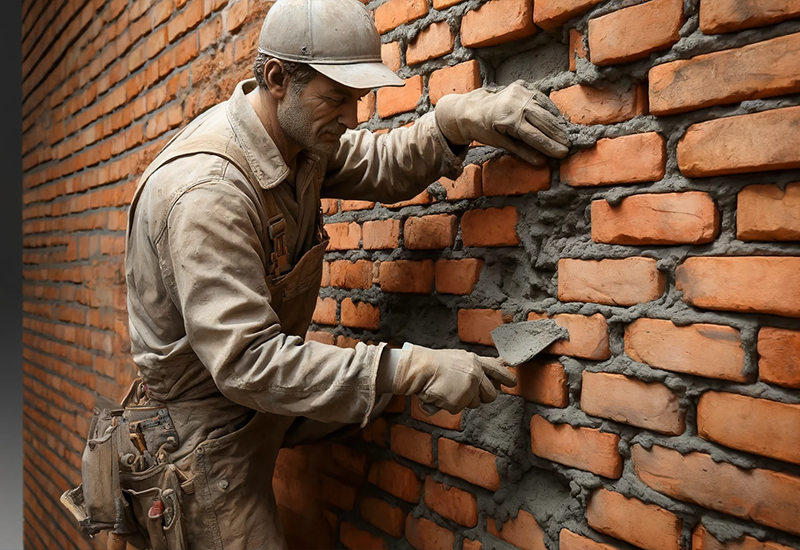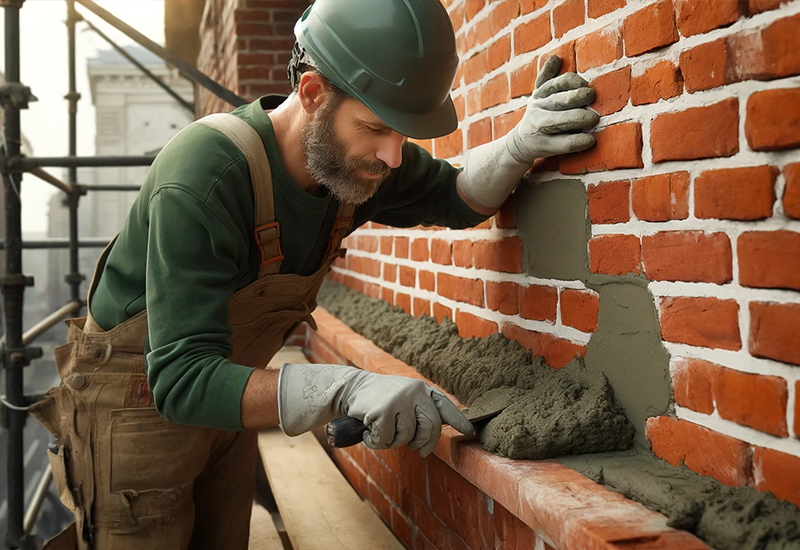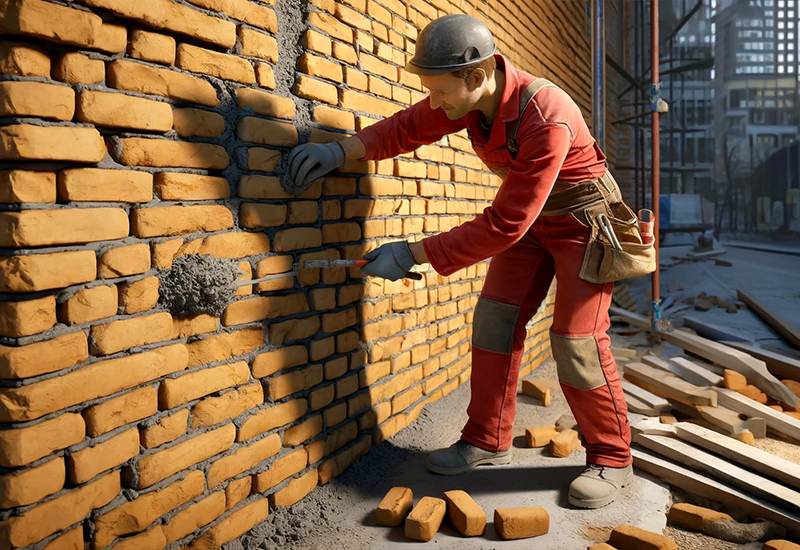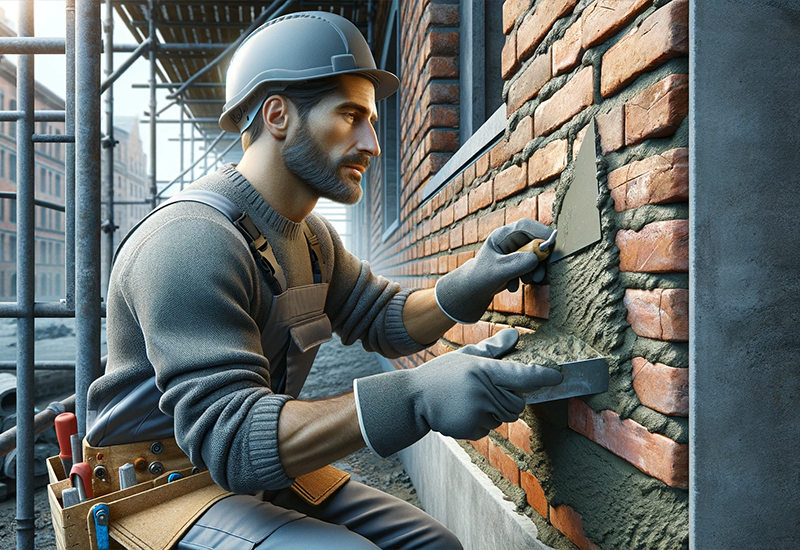
Repointing is a vital maintenance process for any building, especially older ones where mortar deteriorates over time. This guide delves into various types of repointing, detailing how each method can help maintain the structural integrity and appearance of your building. Understanding the right type of repointing is essential for effective masonry care.
Table of Contents
What is Repointing?
Repointing is a vital maintenance task for any masonry structure, aiming to restore the integrity and extend the life of buildings. In this process, we remove the old, deteriorated mortar from the joints of a brick or stone wall and replace it with fresh mortar. Doing this right not only keeps the building looking great but also protects it against water damage and structural decay. It’s a bit like giving your building a health check-up; you remove what’s damaged and reinforce it to stand strong against future challenges.
Choosing the Right Technique for Different Types of Repointing
Choosing the correct technique for repointing is more than just a practical decision; it’s essential for the safety and longevity of your building. The right method helps prevent potential damage, ensuring that the building doesn’t just look good but is structurally sound. On the flip side, the wrong technique can cause more problems down the line, possibly leading to costly repairs. Think of it as choosing the right tool for a job—if you use the wrong one, the job won’t just be harder, but you might end up breaking something else in the process.
Types of Repointing
1. Tuck Pointing

Tuck pointing is truly an art form in masonry. It involves using two distinctly colored mortars: one that matches the bricks, and a lighter color, typically white, to create a sharp contrast. This method doesn’t just fill in the gaps between the bricks; it also creates the illusion of very fine joints, which enhances the overall appearance of the masonry. Tuck pointing is especially valued in historical building restoration projects where maintaining the original look of the façade is crucial. It’s a meticulous process that requires precision, but the end result can dramatically restore a building’s historic charm while ensuring structural stability.
2. Flush Pointing

Flush pointing is favored for its simplicity and effectiveness. Here, the new mortar is applied so that it ends flush with the surface of the bricks or stones, creating a clean, uniform look. This technique is particularly popular in modern constructions or in scenarios where the visual continuity of the brickwork is paramount. It’s straightforward but requires a skilled hand to ensure that the mortar is perfectly level with the masonry, offering a seamless and protective barrier against the elements.
3. Beaded Pointing

Beaded pointing isn’t just functional; it’s decorative. This technique involves forming a small, rounded bead of mortar at the edge of each joint, giving it a raised appearance that can be quite striking visually. The bead not only adds an aesthetic flair to the building but also serves a practical purpose by enhancing the wall’s resistance to rain and moisture. The rounded shape helps water drip away from the joint, reducing the risk of water ingress and the associated damage it can bring. Beaded pointing is perfect for those looking to add a touch of character to their home while improving its durability against weather conditions.
4. Recessed Pointing

Recessed pointing offers a distinctive aesthetic by setting the mortar slightly back from the face of the masonry. This method creates an appealing shadow effect that accentuates each individual brick or stone, giving the wall a more textured and dimensional look. It’s particularly popular in contemporary architectural styles where the design seeks to highlight sharp lines and geometric patterns. Recessed pointing not only looks modern but also can help protect the masonry by limiting direct exposure of the mortar joints to the elements.
5. Weather Struck Pointing

Weather struck pointing, designed with functionality in mind, specifically tailors to manage water runoff in a way that protects the building’s structure. This technique shapes the mortar so that the top edge is cut back from the face of the brick and the bottom edge slightly protrudes, ensuring effective shedding of rainwater away from the brickwork. This clever design greatly enhances the wall’s resistance to water ingress, crucial for maintaining the integrity and longevity of masonry in wet climates.
6. Keyed Pointing

Keyed pointing adds a decorative flair to masonry joints by incorporating a groove down the center of the mortar. This style is chosen more for its visual appeal than its protective qualities. The groove, or ‘key,’ can be varied in depth and width to create different visual effects, making it a versatile choice for adding character to both new and existing buildings. While keyed pointing may not significantly impact the structural aspects of masonry, it’s a fantastic way to elevate the aesthetics of a structure without extensive modifications.
Strategies for Effective Repointing
Discover essential techniques for repointing that ensure the longevity and durability of masonry work. This section covers everything from analyzing the existing mortar to choosing the right time for the job, ensuring your repointing efforts are both effective and lasting.
Assessing the Existing Mortar
Before you begin repointing, it’s crucial to understand what you’re working with. The first step is to analyze the existing mortar. This involves checking its type, age, and material composition. Why is this important? Well, the new mortar you mix needs to match the old one not just in color and texture but also in strength and permeability. This matching ensures that the new mortar adheres properly and behaves similarly under weather conditions, which is vital for the longevity of the repointing work.
Choosing the Right Mortar Mix
Choosing the right mortar mix is more than just sticking to a recipe. You need a mix that complements the building’s historical and structural integrity. For instance, older buildings often require a softer lime-based mortar rather than the modern cement-heavy mixes, which might be too rigid and cause further damage over time. Getting this mix right means the difference between extending your building’s life and potentially shortening it.
Timing and Weather Considerations
Timing your repointing project is also more science than art. The best time for repointing is usually during mild weather—neither too hot nor too cold. Extreme temperatures can lead to quick drying or slow curing of the mortar, both of which can weaken the joints. Also, avoid rainy or humid days, as excess moisture can prevent the mortar from setting correctly.
Applying the Mortar
When applying the new mortar, it’s vital to remove all the old, damaged mortar to a sufficient depth. This depth should be at least twice the width of the joint to ensure the new mortar has enough surface area to bond effectively. You should meticulously fill the joints, pressing the mortar firmly into the gaps to avoid air pockets, which can lead to water retention and eventual deterioration.
Curing the Mortar
After the mortar is applied, curing it properly is crucial. This isn’t just about waiting for it to dry; it’s about allowing it to slowly gain strength. Curing includes keeping the mortar damp for a few days, which helps in achieving the full strength of the mix. People often overlook this step, but it is essential for ensuring the durability of your repointing effort.
Conclusion
Understanding the different types of repointing is crucial for maintaining the health and beauty of your building. Each method offers unique benefits and can significantly impact the longevity and appearance of your masonry. If you’re looking for a professional contractor for repointing services, feel free to reach out at +(1) 917-477-9667 for expert advice and assistance.
FAQs
Q: What are the most common types of repointing?
A: The most common types of repointing include tuck pointing, flush pointing, and beaded pointing, each serving different aesthetic and functional purposes depending on the building’s needs.
Q: How do I choose between different types of repointing?
A: Choosing between types of repointing depends on your building’s age, the condition of the existing mortar, and the desired visual appearance. A professional can help assess which type is best suited for your structure.
Q: Can I mix different types of repointing on the same wall?
A: While it’s technically possible to use different types of repointing on the same wall, it’s crucial to maintain consistency for structural integrity and visual harmony. Consult with a masonry expert to determine the best approach.
Q: What are the costs associated with different types of repointing?
A: The costs may vary widely based on the types of repointing you choose, the wall’s condition, and the area’s accessibility where the work will occur. Generally, more detailed and labor-intensive methods like tuck pointing are costlier.
Q: How long do different types of repointing last?
A: The longevity of repointing work depends on the type used, the quality of materials, and exposure to weather conditions. Generally, a well-done repointing job can last anywhere from 25 to 50 years.


